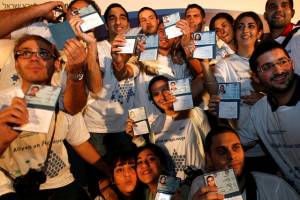The Central Bureau of Statistics released its traditional statistics report on the citizens of Israel in honor of Yom Ha’Atzmaut, Israeli Independence Day, which is celebrated this year on Wednesday night and Thursday.
Israel boasts 8,522,000 citizens, more than 10 times as many as the 806,000 at the time of the establishment of the Jewish state in 1948.
The Jewish population stands at 6,377,000 million, 75 percent of the entire population. Israel’s Arab citizens constitute 20.8 percent of the total population, numbering approximately 1,771,000. Non-Arab Christians and other religious groups constitute 4.4 percent of the population.
Since last year’s Independence Day, Israel’s population grew by 182,000, constituting a 2.2 percent growth, including 195,000 newborn babies; 47,000 people have died.
Israel welcomed 36,000 new immigrants. Some 3.5 million people have made Aliyah (immigration to Israel) since 1948, making up 42 percent of the total population.

Young French immigrants wave their new Israeli ID cards. (Miriam Alster/Flash90)
At the conclusion of 2015, 75% of the population were Israeli-born – known as “sabras” – half of them second-generation. In 1948, only 35% were sabras.
At the time of the establishment of the State of Israel, only one city had more than 100,000 residents – Tel Aviv-Yaffo. Today, 14 cities have over 100,000 residents; eight of them have more than 200,000. They are Jerusalem, Tel Aviv-Yaffo, Haifa, Rishon Letzion, Petah Tikvah, Ashdod, Netanyah and Beer sheva.
Israel’s capital, Jerusalem, is the most-populated city, with some 830,000 residents – almost 10 percent of the population.
According to CBS’ estimates, by 2035 Israel’s population is expected to grow to 11.3 million citizens.
Close to a half of the world’s Jewish population, 43 percent of 14.3 million Jews, lives in Israel.
By: Max Gelber, United with Israel

Do You Love Israel? Make a Donation - Show Your Support!
Donate to vital charities that help protect Israeli citizens and inspire millions around the world to support Israel too!
Now more than ever, Israel needs your help to fight and win the war -- including on the battlefield of public opinion.
Antisemitism, anti-Israel bias and boycotts are out of control. Israel's enemies are inciting terror and violence against innocent Israelis and Jews around the world. Help us fight back!
See our Privacy Policy



